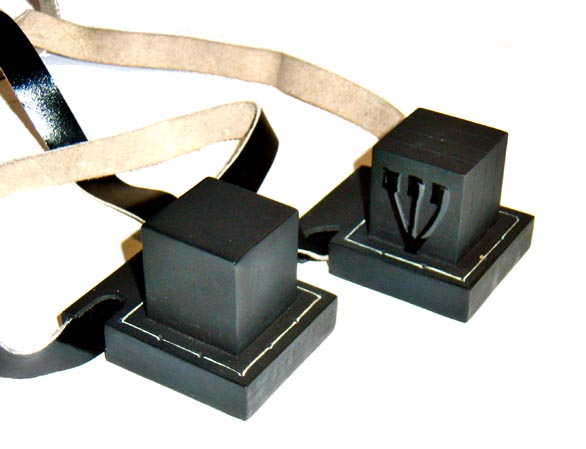Getting a little bit tired of the disingenuous argument that the word "phylactery" in D&D wasn& #39;t originally meant to invoke Jewish tefillin. So I& #39;m going to go through this a different way this time.
In the AD&D Monster Manual (1977), we learn:
"The lich posses from a state of humanity to a non-human, nonliving existence through force of will. It retains this status by certain conjurations, enchantments, and a phylactery."
What& #39;s a phylactery? Who knows?
"The lich posses from a state of humanity to a non-human, nonliving existence through force of will. It retains this status by certain conjurations, enchantments, and a phylactery."
What& #39;s a phylactery? Who knows?
Turns out, the 1st Edition DMG knows! From the glossary:
"Phylactery- An arm wrapping with a container holding religious writings, thus a form of amulet or charm."
I& #39;ll admit to only having access to the 1979 Revised Edition of the DMG, so there& #39;s a possibility things changed.
"Phylactery- An arm wrapping with a container holding religious writings, thus a form of amulet or charm."
I& #39;ll admit to only having access to the 1979 Revised Edition of the DMG, so there& #39;s a possibility things changed.
But this language is SPECIFICALLY taking tefillin—a Jewish ritual object that consists of two sets of leather straps with which boxes containing important religious texts are affixed to the head and arm—and conflating it with the Greek root for the common (mis)translation.
I& #39;ve gone into the etymology of tefillin and phylacteries as soul jars elsewhere, so I won& #39;t repeat that here. Link at the end of the thread. Instead, let& #39;s delve a little deeper.
First: The DMG listing has at least three non-lich phylacteries.
First: The DMG listing has at least three non-lich phylacteries.
The phylacteries of long years, faithfulness, and monster attraction (the last one cursed) are all cleric-only items, reinforcing that these are understood as ritual objects. They& #39;re not just magic items Joe Fighterman can pick up and use.
Second: Prior to AD&D, lich phylacteries didn& #39;t exist at all. Their original appearance as we recognize D&D liches, in the Greyhawk supplement, says liches are "now alive only by means of great spells and will because of being in some way disturbed."
Supplement III: Eldritch Wizardry gave them the possibility of psionic powers, but still: no phylactery. No item of any kind that served as the focus of the lich& #39;s undead might.
Third: Lich& #39;s didn& #39;t return via their phylacteries until later. The idea is first proposed in The Dragon #26, "Bazaar of the Bizarre–Blueprint for a Lich" (subtitle redacted because it& #39;s unnecessary here; you can find it).
This article was written in 1979 by Len Lakofka
This article was written in 1979 by Len Lakofka
The article describes the process by which a spellcaster becomes a lich, how a lich returns when its physical body is destroyed, and the fact that liches lose power with each return to life.
Another interesting point: this article, the word phylactery appears exactly ZERO times.
Another interesting point: this article, the word phylactery appears exactly ZERO times.
That& #39;s right. The idea of the D&D lich returning from destruction comes from an article that never, not once, uses the term we now think applies almost exclusively to that item.
Most D&D players have only ever heard the word phylactery in relation to the lich.
Most D&D players have only ever heard the word phylactery in relation to the lich.
In the article, it& #39;s called a jar.
No fancy word. No religious connotation. No poor translations.
It& #39;s a jar.
No fancy word. No religious connotation. No poor translations.
It& #39;s a jar.
Down through the Rules Cyclopedia (1991), I can& #39;t find any reference in Basic D&D to a lich& #39;s phylactery at all. It seems an element solely of AD&D.
I& #39;m happy to admit being wrong about it, but for now it means I can stick to the progression of editions fairly linearly.
I& #39;m happy to admit being wrong about it, but for now it means I can stick to the progression of editions fairly linearly.
In AD&D 2nd Edition, the Monstrous Compendium Vol 1(1989) is where we finally get the repetitively immortal lich its phylactery. Gone, at least for the lich, is any connection between the phylactery and a religious text worn on the arm or forehead.
The same three non-lich items appear in the DMG, though, and now only one of them is specifically worn on the arm, because there& #39;s no glossary in 2nd Edition to explain what a phylactery "is" in the game& #39;s estimation.
For added confusion, the 2E phylacteries are also on the same random item table as amulets.
Throughout 2E, phylacteries continue to appear in Dragon Magazine and in Al-Qadim, and their descriptions specifically invoke the descriptions of Jewish tefillin.
Throughout 2E, phylacteries continue to appear in Dragon Magazine and in Al-Qadim, and their descriptions specifically invoke the descriptions of Jewish tefillin.
In 3rd Edition, phylacteries got drawn back closer to their tefillin roots. The phylactery of faithfulness is "a small box
containing holy scripture affixed to a leather cord." (3E DMG).
containing holy scripture affixed to a leather cord." (3E DMG).
A lich& #39;s phylactery is most commonly "a sealed metal box containing strips of parchment on which magical phrases have been inscribed... [wit] a leather strap so that the owner can wear it on the forearm or head." (3E Monster Manual). In 4E, the language is almost identical.
By 5E, the only phylactery in the game is the lich& #39;s phylactery, and it& #39;s "traditionally an amulet in the shape of a small box." (5E Monster Manual) Still evoking tefillin, but now without any counterbalance in the form of beneficial magic items of any sort.
There is not a single edition of D&D that uses the word phylactery but doesn& #39;t understand it as a placeholder for "tefillin, except a tiny bit more generic" (i.e. less Jewish).
In my thread a couple of years ago, I suggested that perhaps "phylactery" was used as a cool-sounding word, in lieu of amulet, that then grew to encompass multiple items.
I no longer believe that.
I no longer believe that.
It& #39;s now clear that Gygax specifically used the word to connect what Jews call tefillin with magical amulets and protective wards. Which they categorically are not.
Tefillin are signs and reminders of obligations. In that sense, only the phylactery of faithfulness is "correct."
Tefillin are signs and reminders of obligations. In that sense, only the phylactery of faithfulness is "correct."
Just to make a couple of things clear:
-I AM NOT saying that the use of the word phylactery is antisemitic. As a Jew, I have always disliked the term phylactery to describe tefillin, but it isn& #39;t hateful. It is inaccurate, or at best, incomplete. Tefillin are not amulets.
-I AM NOT saying that the use of the word phylactery is antisemitic. As a Jew, I have always disliked the term phylactery to describe tefillin, but it isn& #39;t hateful. It is inaccurate, or at best, incomplete. Tefillin are not amulets.
-I would prefer that the game not use the word phylactery, because outside of D&D, the word is generally associated solely with tefillin, so most people doing a search will make a one-to-one correlation between a lich& #39;s phylactery and Jewish tefillin. Which is not comfortable.
-The use of the term phylactery *specifically for the lich& #39;s soul repository* is a holdover from previous editions and probably should go. Because, well, all this.
At minimum, a lich& #39;s phylactery (whether tefillin-style or not) should have to be worn, and that& #39;s not the case.
At minimum, a lich& #39;s phylactery (whether tefillin-style or not) should have to be worn, and that& #39;s not the case.
If you want some background on how tefillin became phylacteries became those weird jar-looking things in World of Warcraft and elsewhere, feel free to check out my original thread: https://twitter.com/briancortijo/status/994609911068798976">https://twitter.com/briancort...
If you& #39;ve genuinely never seen tefillin before, here is what they look like. One is worn on the forehead, the other on the nondominant arm (from bicep to fingers). THIS is the "arm wrapping with religious writings" that D&D originally understood a phylactery to be.

 Read on Twitter
Read on Twitter



